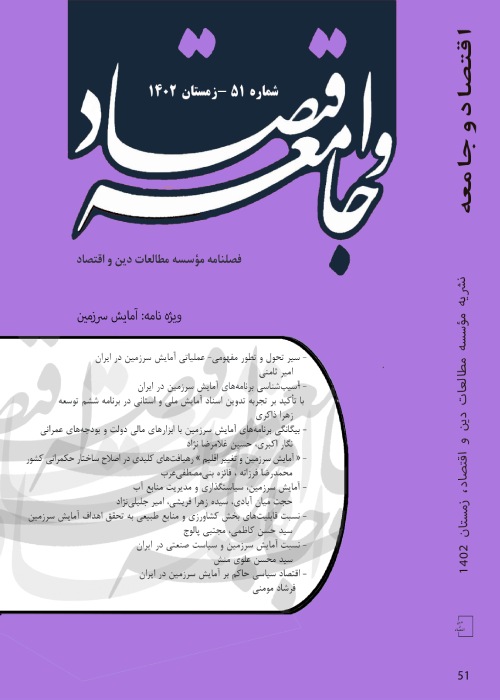The Role of Agriculture in the Current Conditions of Lake Urmia (Agriculture and Lake Urmia)
Author(s):
Abstract:
The drying up of Lake Urmia caused many challenges in northwest of Iran. The impact of this disappearance will have negative influences on climate status, water resources, biodiversity and natural environment of the lake, economy, livelihoods and public health of the region. Natural and human factors and Decades of unbalanced and unstable development caused the current conditions in the lake. The study aims to present a documented picture of the human and natural factors changes associated with and effective in the Lake Urmia. Therefore, the study addresses the factors including, “precipitation”, "agricultural cropping area", and “demographic changes”, “Construction of dams and illegal use of underground water”. The results show that in recent decades the level of crop cultivation of agricultural crops (crops and gardens) in the plains located in the lake of Urmia has decreased by more than 10 thousand hectares. Therefore, the increase of level of cropping should not be considered as the main factor in the drying of Lake Urmia. Demographical changes increase demand for drinking water, welfare and health. The population in the basin of Lake Urmia increased 14 percent in recent decades. The rate of urban population to total population was 68 percent in 2006, but increased by 5% in 2016 to 73%. One of the barriers and controlling factor of the water flaw into the lake is dam construction. The number of dams in the Urmia basin has increased and, in total, 104 dams with the ability to adjust 3949 cubic meter of water is exploited or under study or construction. The rule of law should be considered as the other important factor in water flaw management of the lake. Investigating the exploitation license, as a law enforcement tool in the exploitation of groundwater resources, suggests that about 66 percent of the agricultural wells in the area lacking a license or exploitation license are unclear. In the last 15 years (2003-2018), precipitation as the primary natural factor to feed the lake and the humidity of the region, compared to a long-term, decline of 2.4%. During the same period, the precipitation dropped to 192 mm, which is significantly different from that of 2013 (543 mm). Temperature, the other natural factor affecting the lake Uremia region, has increased significantly in recent years at around 1.8 ° C over the long run, which rank the basin the second among the other 30 basins. As temperature increases the process of evaporation and transpiration goes up accordingly which causes draught in more than 97 percent of the basin.
Keywords:
agriculture development , draught , climate , dam , well , population
Language:
Persian
Published:
Journal of Economy and Society, Volume:14 Issue: 33, 2017
Pages:
11 to 37
magiran.com/p1976710
دانلود و مطالعه متن این مقاله با یکی از روشهای زیر امکان پذیر است:
اشتراک شخصی
با عضویت و پرداخت آنلاین حق اشتراک یکساله به مبلغ 1,390,000ريال میتوانید 70 عنوان مطلب دانلود کنید!
اشتراک سازمانی
به کتابخانه دانشگاه یا محل کار خود پیشنهاد کنید تا اشتراک سازمانی این پایگاه را برای دسترسی نامحدود همه کاربران به متن مطالب تهیه نمایند!
توجه!
- حق عضویت دریافتی صرف حمایت از نشریات عضو و نگهداری، تکمیل و توسعه مگیران میشود.
- پرداخت حق اشتراک و دانلود مقالات اجازه بازنشر آن در سایر رسانههای چاپی و دیجیتال را به کاربر نمیدهد.
دسترسی سراسری کاربران دانشگاه پیام نور!
اعضای هیئت علمی و دانشجویان دانشگاه پیام نور در سراسر کشور، در صورت ثبت نام با ایمیل دانشگاهی، تا پایان فروردین ماه 1403 به مقالات سایت دسترسی خواهند داشت!
In order to view content subscription is required
Personal subscription
Subscribe magiran.com for 70 € euros via PayPal and download 70 articles during a year.
Organization subscription
Please contact us to subscribe your university or library for unlimited access!


